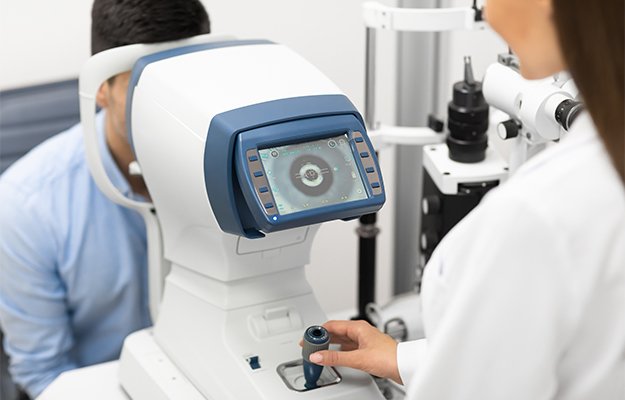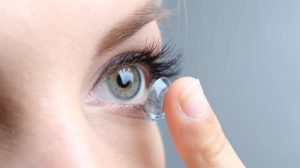Diabetes is a metabolic disorder that causes too high blood glucose levels in millions of people worldwide.The prevalence is rising dramatically in the last decade, especially in low- and middle-income countries.

Diabetes can give rise to various health complications all over your body since it affects all the small blood vessels.
Diabetic retinopathy is a common eye complication of diabetes. However, did you know you can reduce the risk of developing diabetic retinopathy with discipline and simple daily practices?
Here’s what you can do to reduce the risk of developing diabetic eye disease:
Visit your Eye Doctor for an Annual Eye Exam
Everyone should have regular eye exams, but for diabetes patients, it’s especially important to have annual eye exams. Early stages of diabetic retinopathy can be asymptomatic for a long time, but that doesn’t mean no damage is being done. When you do experience symptoms like blurry vision, flashes, dark spots, or vision loss, contact your ophthalmologist right away.
An annual eye exam is important to keep track of the disease progression and to intervene on time when necessary.
Furthermore, diabetes affects the small blood vessels in your entire body, not just in your eyes. The difference is, that the blood vessels in your eyes can be seen directly by your eye doctor.
If changes due to diabetes appear in the eyes, similar changes will also be present in areas like your kidneys, feet, and all other parts of the body with blood vessels. Timely diagnosis leads to more successful treatments and better outcomes, whatever the part of the body that is affected.
Monitor Your Blood Sugar
Continuous high blood sugar levels are bad for the small blood vessels in your body, especially in your eyes. Managing your blood glucose levels is essential in reducing the risk of diabetic retinopathy and the associated vision loss.
A glucose meter is one of the methods to take control of your blood sugar levels at home.
More specialized blood tests like HbA1C reflect your blood glucose levels over a longer period of time.
With glucose monitoring, you can adjust your medication accordingly and keep levels under control.
Stick to a Healthy Diet
A healthy diet is another significant way to help manage blood sugar levels.
The most harmful foods for diabetes are sugary and sweet foods, including fast foods, soda, cereals, dried fruits, packaged nuts, juices, flavored yogurts, but also white bread, pasta and rice.
So what foods are safe to eat for people with diabetes? Here are some of the best diabetic-friendly foods:
- Fatty fish
- Dark green vegetables
- Eggs
- Beans
- Whole grains
- Plant-based proteins
- Greek yogurt
- Nuts
- Flaxseeds
- Garlic
- Chia seeds
- Avocados
Manage Your Cholesterol Levels
If you have diabetes, you will likely have lower levels of HDL cholesterol (good cholesterol) and higher levels of LDL cholesterol (bad cholesterol). High blood glucose levels damage the wall of the small blood vessels and make it more likely for cholesterol to stick to them, increasing the risk of narrowing them or making them blocked. Check and control your cholesterol levels regularly with diet and medication, if needed.
Exercise
Exercise is very beneficial for controlling blood sugar levels. It increases your sensitivity to insulin and lowers blood sugar levels. Physical exercise also reduces your cholesterol, lowers your blood pressure and your risk of heart disease.
You don’t have to do intense workouts. Simple, light exercises, like walking, jogging, swimming, and cycling, can have positive effects. It’s always best to consult your doctor before starting any new exercise regimen.
Quit Smoking and Alcohol
The negative health effects of smoking are well documented and for diabetes patients, smoking makes managing diabetes also more difficult. Nicotine increases blood sugar levels and often more insulin is needed to lower these. Smoking also increases the risk of developing type 2 diabetes by 30-40%.
Diabetes patients can drink 1-2 glasses of wine, but need to be aware of the alcohol’s effect on the body. Moderate amounts of alcohol usually cause a rise in blood glucose levels, but larger amounts can actually decrease the levels, sometimes to dangerously low levels. Excess alcohol intake is associated with an increased risk of type 2 diabetes.
Wear Eye Protection
UV exposure is linked to cataracts and age-related macular degeneration. Wear protective eyewear when going outside and wear sunglasses that block 100% of damaging UV rays.
Take Breaks When Using a Computer

Long hours of using a computer or other digital device cause digital eye strain.
The 20-20-20 rule is a simple practice that you can follow to proactively protect your eyes from digital eye strain and other eye problems: every 20 minutes, take a 20-second break by looking at an object at least 20 feet away.
De-stress
Too much stress and anxiety are linked to higher risks of retinopathy.
Stress causes the release of cortisol, the stress hormone, which is linked to inflammation and leakage of small blood vessels, exacerbating the damage caused by diabetes. Stress can also cause or increase insulin resistance and higher blood glucose levels. All these factors increase the risk of or exacerbate diabetic retinopathy.
Seek Help When Needed
Keeping up with your vision allows you to notice changes in your vision early. Dark spots in your vision field can indicate leaking blood vessels in the retina or an increase in flashes or floaters may indicate a retinal detachment. Always contact your ophthalmologist when symptoms arise. This practice allows your doctor to devise an appropriate treatment plan to protect and preserve your vision when you have diabetes.
If you have diabetes and want to take control of your eye health throughout the years, schedule a visit to the European Eye Center today.
Every patient deserves top-quality eye care from us. European Eye Center focuses on providing Western-standard services and determining appropriate treatment plans to help patients restore their vision in a feel-like-home atmosphere.
We are happy to help if you have questions about diabetic retinopathy. Don’t hesitate to connect with us at info@europeaneyecenter.com.
Contact us today to schedule an eye care service!







